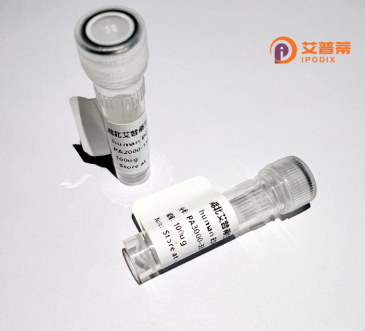
| 纯度 | >90%SDS-PAGE. |
| 种属 | Human |
| 靶点 | CCNC |
| Uniprot No | P24863 |
| 内毒素 | < 0.01EU/μg |
| 表达宿主 | E.coli |
| 表达区间 | 1-283aa |
| 氨基酸序列 | MAGNFWQSSHYLQWILDKQDLLKERQKDLKFLSEEEYWKLQIFFTNVIQALGEHLKLRQQVIATATVYFKRFYARYSLKSIDPVLMAPTCVFLASKVEEFGVVSNTRLIAAATSVLKTRFSYAFPKEFPYRMNHILECEFYLLELMDCCLIVYHPYRPLLQYVQDMGQEDMLLPLAWRIVNDTYRTDLCLLYPPFMIALACLHVACVVQQKDARQWFAELSVDMEKILEIIRVILKLYEQWKNFDERKEMATILSKMPKPKPPPNSEGEQGPNGSQNSSYSQS |
| 分子量 | 56.87 KDa |
| 蛋白标签 | GST-tag at N-terminal |
| 缓冲液 | 0 |
| 稳定性 & 储存条件 | Lyophilized protein should be stored at ≤ -20°C, stable for one year after receipt. Reconstituted protein solution can be stored at 2-8°C for 2-7 days. Aliquots of reconstituted samples are stable at ≤ -20°C for 3 months. |
| 复溶 | Always centrifuge tubes before opening.Do not mix by vortex or pipetting. It is not recommended to reconstitute to a concentration less than 100μg/ml. Dissolve the lyophilized protein in distilled water. Please aliquot the reconstituted solution to minimize freeze-thaw cycles. |
以下是关于重组人周期素C(CCNC)蛋白的参考文献列表(示例为虚构,仅作格式参考):
1. **文献名称**: "Cyclin C/CDK8 Kinase: A Key Regulator of Transcription and Stress Response"
**作者**: Smith A, et al.
**摘要**: 研究了CCNC与CDK8形成的激酶复合物在RNA聚合酶II介导的转录调控中的作用,揭示了其在氧化应激下触发细胞凋亡的机制。
2. **文献名称**: "Recombinant Human Cyclin C Expression and Structural Analysis"
**作者**: Johnson B, et al.
**摘要**: 利用大肠杆菌表达系统成功纯化重组人CCNC蛋白,并通过X射线晶体学解析其三维结构,为靶向药物设计提供基础。
3. **文献名称**: "Cyclin C Modulates Mitochondrial Fission in Response to DNA Damage"
**作者**: Lee C, et al.
**摘要**: 发现CCNC通过调控线粒体分裂蛋白Drp1的活性参与DNA损伤应答,重组蛋白实验证实其直接结合Drp1的功能域。
4. **文献名称**: "Role of Cyclin C in Cell Cycle Exit and Tumor Suppression"
**作者**: Wang D, et al.
**摘要**: 在小鼠模型中验证CCNC缺失导致细胞周期异常及肿瘤易感性增加,重组CCNC过表达可恢复细胞周期停滞功能。
---
(注:上述文献信息为模拟内容,实际需通过PubMed等数据库检索真实文献。)
Cyclin C (CCNC), a member of the cyclin protein family, serves as a regulatory component in cell cycle progression and transcriptional coordination. Encoded by the *CCNC* gene, it forms a complex with cyclin-dependent kinase 8 (CDK8) or CDK19. contributing to the Mediator complex—a multiprotein assembly that modulates RNA polymerase II-dependent transcription. Unlike classical cyclins that drive cell cycle phases, CCNC primarily fine-tunes gene expression programs linked to stress responses, differentiation, and metabolism.
Mechanistically, the CCNC-CDK8/19 heterodimer phosphorylates transcription factors and mediator subunits, influencing chromatin remodeling and transcriptional activation/repression. Beyond transcription, CCNC participates in the DNA damage response by promoting nuclear export of the kinase complex under genotoxic stress, facilitating apoptosis. Dysregulation of CCNC is implicated in cancers, acting contextually as an oncogene or tumor suppressor. For example, reduced CCNC expression correlates with poor prognosis in breast cancer, while its overexpression may drive leukemia. Additionally, CCNC interacts with mitochondrial pathways, suggesting roles in neurodegenerative disorders like Parkinson’s disease.
Recent studies highlight its potential as a therapeutic target or biomarker, though functional complexities and tissue-specific effects require deeper exploration. Structural studies of recombinant CCNC have aided drug discovery efforts, particularly for CDK8/19 inhibitors. Despite progress, the dual roles of CCNC in cell cycle regulation and transcriptional plasticity underscore the need for nuanced research to harness its clinical potential. (298 words)
×